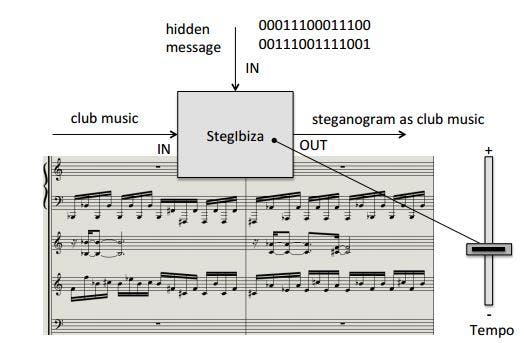
Ibiza is famous for its sunny beaches and drunk Englishmen but most of all for its booming party scene. While you can find a wide range of entertainment offerings, by far the most popular kind of music you’ll hear in clubs on the Balearic island is trance and techno, electronic music meant to shake your mind and body with stomping rhythms and varying tempos.
Many Ibiza clubgoers go by the mantra “God is a DJ”, but Polish cybersecurity researcher Krzysztof Szczypiorski took it to a whole new level by producing tunes with hidden coded messages nested inside tempo variations.
What Szczypiorski did was to basically write musical steganography, a technique that involves coding messages in music. As far back as the 16th century in the time of Benedictine monk Johannes Trithemius until more recently, artists have toyed with musical steganography to subtly disseminate a message by doing things like mapping notes to letters. Say what you will about electronic music, but if there’s one thing it’s got going for it is control. Nowadays, digital audio workstations are so versatile that you can go nuts with a lot of things, from virtual instruments to advanced automation of sound envelopes to embedding code.
First, Szczypiorski re-wrote some tunes like “Miracle” by Queen at 92 beats per minute, “So What” by Miles Davies at 120 beats per minute, and “Rhythm Is a Dancer” by Snap at 130 beats per minute using his own instruments, vocals not included. The message he wanted to convey wasn’t coded in the frequencies, but in variations of the tempo — a technique Szcypiorski calls StegIbiza. It’s Morse code, basically. To indicate a dash, he speeds up the tempo for a single beat; to indicate a dot, he slows it down, MIT Technology Review reported.
“It is very easy—it is just tuning the tempo which is visible as a curve in [Digital Audio Workstations like Logic],” Szczypiorski told MotherBoard. “The shape of this curve could be changed by a mouse and follow adopted Morse mode or any coding scheme. For the live mixing it is just usage of tempo slide on the DJ controller—limited only by manual skills of a DJ.”
In each track, the Polish researcher spelled “Steganography is a dancer!” hidden in two random locations in the songs’ timeline. In Morse code, the message is:
… – . –. .- -. — –. .-. .- .–. …. -.–
.. … .- -.. .- -. -.-. . .-. -.-.—
Check out one of the songs below and see if you can tell where the message was spelled.
To test whether or not people could notice, Szczypiorski made two experiments. In the first, he held a listening session with twenty people, half of whom had a background in music, and found that if the tempo was varied by more than 3 percent people would notice. When the change was less than 2 percent, nobody did. Similar results were reported in a more informal setting at an open-air party with 70 people in attendance. “At this level the experiment was stopped, because the rest of the party did not care about the music,” he says.
So, what are the applications of this sort of technique? Spies could send coded messages by exploiting the underground party scene. Ok, that’s unlikely. Still, the method could prove useful as a marketing ploy for musicians to keep fans engaged or as a digital signature key to spot pirated tracks. Either way, next time you see your favorite DJ be on the look out for a message. You never know if it’s the booze or god is really a DJ.


